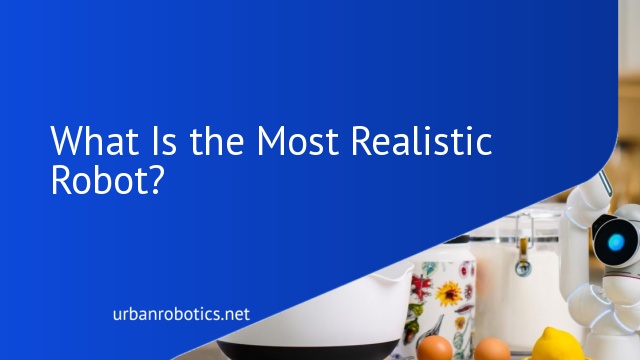What about wandering around shops and taking your favourite human-like friend home to help you with household chores you hate to do yourself?
Though that day of making humanoid robots cheaper and available for household purposes is a long way off, technology is evolving at a breathtaking pace, and once the stuff of futuristic fantasies, intelligent robotics, has truly come into its own in the last few decades! In fact, some tech-giant robot builder businesses have already created some stunning research-purpose humanoids that make us think the future is now – thanks to the impressive advancements in Artificial Intelligence and locomotion.
But what is the most realistic robot? To learn more about real-life humanoid robots, read on.
What Is a Robot?
Robots are programmable devices designed and constructed to accomplish a set of complicated activities autonomously or semi-autonomously. While an autonomous robot needs no human intervention for a specific time to gather information about its surrounding environment and act accordingly, a semi-autonomous one can have some degree of self-governance to react independently. It means all robotic machines are programmed to be at least semi-autonomous.
So the core concepts of a robot are:
- It is a programmable device.
- It can receive commands interactively in the form of electric/hydraulic/pneumatic signals from the physical world via sensors, transmit them to the control system, and has interconnected motors known as actuators to make joint segments or robot muscles move
- They can be both autonomous and semi-autonomous.
A software robot is an AI-powered programmable system hosted on a virtual machine, computer, or physical server that can accomplish computer tasks autonomously, for instance, a chatbot or web crawler. As a software robot is not a physically structured machine and exists on the internet only, it is not a ‘real’ robot.
What Can a Robot Do?
From assisting in surgery to collecting samples from space, robotic intelligence is fastly extending to help humans tremendously and transform the way we live.
Let’s look through some of the capabilities of expanding the robot industry:
- Robots help automate and streamline repetitive industrial activities.
- Can identify risks like gas leaks in unanticipated or unsafe environments.
- Perform dangerous industrial tasks ensuring better security for employees
- Automate report processing and delivery systems for better business security.
- Help doctors provide patients with intelligent therapeutics.
- Robots can help kids with special needs by acting as an automatic yet interactive teaching aid and more.
Though some often mix up robotics and AI, they are entirely two different concepts.
While robotics is an interdisciplinary sector of computer engineering behind the technology of constructing robots, for instance, cobot, AI deals with developing codings, programs, and algorithms and leverages machines and computers to enable them to simulate the natural intelligence of animals or even humans.
When you incorporate AI algorithms with robotics, you get AI robots that have more sophisticated and intelligent capabilities with diverse functionalities. Not all robots need to be AI-powered. However, they are limited in capabilities.
What is Humanoid Robot
Robots can be of various dimensions or forms that can execute different actions. But, perhaps, the most fascinating, and incredible type of breakthrough in robotics are the real-like humanoid robots that mimic humans.
A humanoid robot is a specially programmed robot and an implementation of the most sophisticated locomotion, robotics, and AI that replicate the human body, behaviours, interactions, and even facial expressions and emotions.
Since the tremendous success of the first-ever full-scale intelligent human-like robot WABOT-1 in 1972, roboticists have been longing to materialise their long-cherished dream – enabling humanoid robots to co-exist with human society and radically improve human life. And the recent skyrocketing trend of employing humanoid robots in medical, research, and industrial sectors indicates that realistic robots will soon be available commercially for mass use.
The humanoid market is already on fire – the Verified Market Research says that the global humanoid robot market was valued at 903.5 million dollars in 2020 and is estimated to hit 26401.4 Million dollars by 2028, increasing at a CAGR of staggering 52.53%.
Different Humanoid Robots
Let’s get insight into some real-life robots that will spellbind you:
Sophia
Perhaps the most famous realistic robot today is Sophia, an AI-powered social humanoid designed and constructed by Hanson Robotics, a Hong Kong-based company that brings socially intelligent robots to life.
This five-year-old Gynoid (female humanoid) can speak to humans, recognise them, mimic their facial expressions, crack jokes, create arts and even sing. As an incredible mix of modern technology, art, and science, this female real-life robot acts as a catalyst to facilitate robotics research, shaping and personifying the futuristic fantasy of advanced AI.
Blending symbolic AI, expert systems, NLP, machine perception, cognitive architecture, neural networks, and more, Sophia can react most relevantly based on unique surroundings or communication. This ‘hybrid human-real AI intelligence’ robot is programmed to operate in its full-scale AI automated mode sometimes or run mixing AI with human-produced terms to ensure she can curate communication and respond most precisely.
Sophia, bearing a striking resemblance to the Hollywood superstar Audrey Hepburn, is now officially a Saudi Arab citizen since 2017.
Nadine
Have you ever thought about being attended by a machine while interacting with a company’s customer service? Perhaps Nadine, an intelligent gynoid and the most life-like robot with her ‘own personality’ might answer your queries. Currently working as an expert receptionist in the AIA Singapore, Nadine, the super-intelligent social robot, is an incredible innovation with human-like skin, arms, and hair, and resembles her human creator, professor Nadia Magnenat Thalmann.
Developed by Kokoro Japan and Nanyang Technological University, Nadine has face, gesture, and speech recognition capabilities, can greet you back, shake your hand, make eye contact, localise objects and even grasp them like humans. Plus, as a blend of state-of-the-art robotics with advanced AI, she can show emotions while communicating with humans, read stories, help people with special requirements, send messages, start skype sessions, use Nadine Episodic Memory to interact fruitfully by retrieving appropriate sentences from the past conversation, and the list goes on.
Erica
Say hello to Erica, a human-made advanced android-designed AI superstar humanoid developed by Osaka University, Kyoto University, and ATR, Japan, who has nabbed the lead role in a Hollywood science fiction movie! Though this gynoid cannot walk, she can comprehend natural language, has embedded facial recognition technology and speech and motion-generation algorithms. This autonomous eerie robot with an ultra-realistic human-like appearance possesses a synthesised human voice and can skillfully communicate with humans showing emotions accordingly. More impressively, she can blink her eyes and nod her head while listening – thanks to the 15 built-in advanced infrared vision sensors embedded in the eyes of this humanoid that help track actions and movements efficiently.





